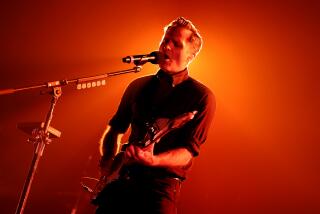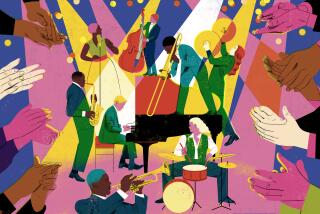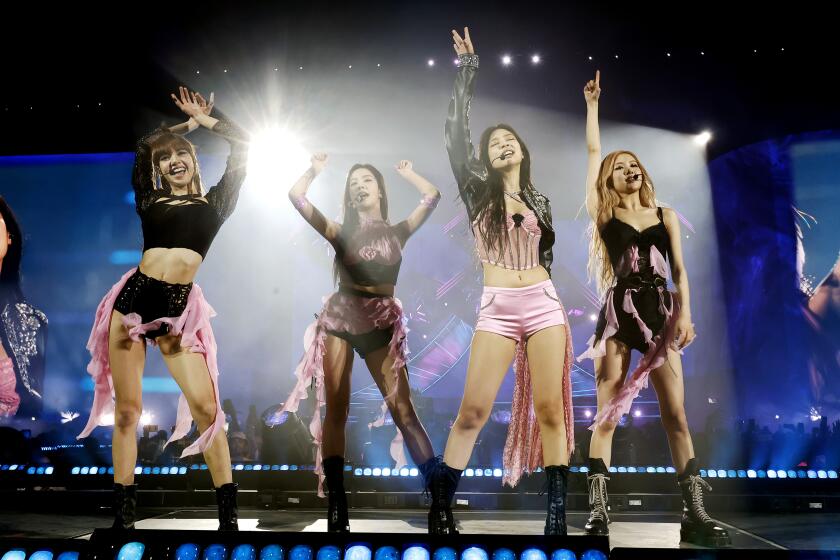A NEW ROUND OF FOLK FROM WASHINGTON SQUARES
- Share via
As the Washington Squares performed on “The Late Show” last week, a group of musicians from the bar band working with that night’s host watched the monitor in the green room, snickering at the Squares’ beatnik appearance. Black turtlenecks, berets, shades and goatees are meant to be laughed at, aren’t they?
But as the performance went on, the musicians’ reaction went from chuckles to, “Hey, they’re not too bad” and finally to unadulterated praise.
That, it seems, is a common reaction to the Squares.
“They are funny,” Squares singer and bassist Tom Goodkind said of the band’s get-ups. “This is as much entertainment as anything else. But when people hear the music. . . .”
It’s understandable that on first impression people might take the idea of three New York new wave veterans singing originals like “New Generation” and folk classics like “Samson and Delilah” with perfect Peter, Paul & Mary harmonies as some kind of cynical, Spinal Tap-like joke.
Even knowing their individual backgrounds doesn’t alter that image. Goodkind used to book concerts at New York’s Peppermint Lounge, singer-guitarist Bruce Jay Paskow writes some of the humorous fake letters to the editor for National Lampoon magazine, and singer-guitarist Lauren Agnelli has made a name for herself as a rock critic under the nom de plume Trixie A. Balm.
But Goodkind insists that the Washington Squares (who perform tonight at At My Place) were formed four years ago out of nothing but the sincerest affection for the vintage folk music of the musicians’ Greenwich Village base, and the associated left-wing social and political causes.
“We became what we set out to be,” Goodkind said proudly.
Interrupted Paskow, a wry wag with a hip comic’s wit and timing: “You mean we wanted to become impoverished musicians performing an unwanted genre?”
Picking up the ball, Goodkind added, “When we started, we said, ‘Folk music is the most unpopular style.’ ”
Elaborated Paskow, facetiously: “Herpes, death and folk music were about equal. We don’t want to brag, but we’ve sold hundreds of records. You’ve heard of gold and platinum? Well our record has just gone cheese.”
But despite the Squares’ humor about the nature of their act (in truth, their debut album has been a college radio hit, and the pop song “Can’t Stop the Rain” has garnered some mainstream radio play), the anachronistic attire, the Peter, Paul & Mary harmonies and the leftist ideals are the Squares’ bottom line, not its punch line.
The singers are pretty accurate when they relate their approach thematically to the social consciousness of U2 and Bruce Springsteen, and musically to the aggressive semi-acoustic sounds of the Violent Femmes and the Knitters. (Musical contributions have also come from former Television drummer Billy Ficca and producer Mitch Easter, who recorded the group’s album). But the foundation of their sound is the early ‘60s Village folk scene they were exposed to as grade-schoolers.
Early in the group’s history, they even made a pilgrimage to a Peter, Paul & Mary concert--or PP&M;, as Agnelli calls their heroes.
“We hung out at the backstage door afterward,” said Agnelli, noting the irony of the fact that the Squares’ album was released by the new Gold Castle label, whose roster is currently dominated by old folkies Joan Baez, Judy Collins and--yes--Peter, Paul & Mary. “We were singing ‘Cruel War’ and Mary came out and listened and then cupped our faces in her hands and sang with us.”
Today the group takes its mission so seriously that it has several meetings a week to discuss current headlines and their relationship to the group’s repertoire, and even uses a Washington political advocate as an adviser. The band’s proudest moments? Being asked to participate in anti-apartheid rallies at UC Berkeley and Columbia University, and performing for New York newspaper strikers--teaching a new generation the organizing songs of the past.
But aren’t the clothes and beatnik cool a gimmick that obscures the purpose of the music?
“Frankly, yes,” said Goodkind. “Mostly people just look at the outfits. But when people put us down I feel they’re too cynical to get it.”
Even some of the leading figures of the original Village folk movement have questioned the Squares’ approach.
“We met Pete Seeger and Ronnie Gilbert and Allen Ginsberg--we appeared on stage with him,” said Goodkind. “And they wondered why we dress as beatniks. We said we don’t want to dress like English guys. We want people to know we’re from the Village. The outfits are funny. This is as much entertainment as anything else. We want kids to dress like this and pretend to be cool and maybe someday they’ll be cool.”
“Anyway,” added Agnelli, “now that our outfits are falling apart, we don’t know what we’re going to do next.”
More to Read
The biggest entertainment stories
Get our big stories about Hollywood, film, television, music, arts, culture and more right in your inbox as soon as they publish.
You may occasionally receive promotional content from the Los Angeles Times.







